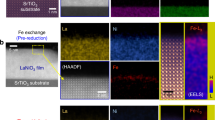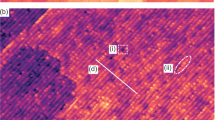Abstract
Although perovskite oxides hold promise in applications ranging from solid oxide fuel cells to catalysts, their surface chemistry is poorly understood at the molecular level. Here we follow the formation of the first monolayer of water at the (001) surfaces of Srn+1RunO3n+1 (n = 1, 2) using low-temperature scanning tunnelling microscopy, X-ray photoelectron spectroscopy, and density functional theory. These layered perovskites cleave between neighbouring SrO planes, yielding almost ideal, rocksalt-like surfaces. An adsorbed monomer dissociates and forms a pair of hydroxide ions. The OH stemming from the original molecule stays trapped at Sr–Sr bridge positions, circling the surface OH with a measured activation energy of 187 ± 10 meV. At higher coverage, dimers of dissociated water assemble into one-dimensional chains and form a percolating network where water adsorbs molecularly in the gaps. Our work shows the limitations of applying surface chemistry concepts derived for binary rocksalt oxides to perovskites.
This is a preview of subscription content, access via your institution
Access options
Subscribe to this journal
Receive 12 print issues and online access
$259.00 per year
only $21.58 per issue
Buy this article
- Purchase on Springer Link
- Instant access to full article PDF
Prices may be subject to local taxes which are calculated during checkout





Similar content being viewed by others
References
Adler, S. B., Lane, J. A. & Steele, B. Electrode kinetics of porous mixed-conducting oxygen electrodes. J. Electrochem. Soc. 144, 1881–1884 (1996).
Kilner, J. A. & Burriel, M. Materials for intermediate-temperature solid-oxide fuel cells. Annu. Rev. Mater. Res. 44, 365–393 (2014).
Tarancón, A., Burriel, M., Santiso, J., Skinner, S. & Kilner, J. Advances in layered oxide cathodes for intermediate temperature solid oxide fuel cells. J. Mater. Chem. 20, 3799–3813 (2010).
Gorte, R. J. & Vohs, J. M. Catalysis in solid oxide fuel cells. Annu. Rev. Chem. Biomol. Eng. 2, 9–30 (2011).
Graves, C., Ebbesen, S. D., Jensen, S. H., Simonsen, S. B. & Mogensen, M. B. Eliminating degradation in solid oxide electrochemical cells by reversible operation. Nature Mater. 14, 239–244 (2014).
Laguna-Bercero, M. A. Recent advances in high temperature electrolysis using solid oxide fuel cells: A review. J. Power Sources 203, 4–16 (2012).
Tsekouras, G. & Irvine, J. T. S. The role of defect chemistry in strontium titanates utilised for high temperature steam electrolysis. J. Mater. Chem. 21, 9367–9376 (2011).
Habib, M. A., Nemitallah, M. & Ben-Mansour, R. Recent development in oxy-combustion technology and its applications to gas turbine combustors and ITM reactors. Energy Fuels 27, 2–19 (2013).
McDaniel, A. H. et al. Sr- and Mn-doped LaAlO3−δ for solar thermochemical H2 and CO production. Energy Environ. Sci. 6, 2424–2428 (2013).
Suntivich, J. et al. Design principles for oxygen-reduction activity on perovskite oxide catalysts for fuel cells and metal–air batteries. Nature Chem. 3, 546–550 (2011).
Suntivich, J., May, K. J., Gasteiger, H. A., Goodenough, J. B. & Shao-Horn, Y. A perovskite oxide optimized for oxygen evolution catalysis from molecular orbital principles. Science 334, 1383–1385 (2011).
Freund, H.-J. & Pacchioni, G. Oxide ultra-thin films on metals: New materials for the design of supported metal catalysts. Chem. Soc. Rev. 37, 2224–2242 (2008).
Besenbacher, F. et al. Design of a surface alloy catalyst for steam reforming. Science 279, 1913–1915 (1998).
Siahrostami, S. et al. Enabling direct H2O2 production through rational electrocatalyst design. Nature Mater. 12, 1137–1143 (2013).
Burriel, M. et al. Absence of Ni on the outer surface of Sr doped La2NiO4 single crystals. Energy Environ. Sci. 7, 311–316 (2013).
Lee, W., Han, J. W., Chen, Y., Cai, Z. & Yildiz, B. Cation size mismatch and charge interactions drive dopant segregation at the surfaces of manganite perovskites. J. Am. Chem. Soc. 135, 7909–7925 (2013).
Kubicek, M., Limbeck, A., Frömling, T., Hutter, H. & Fleig, J. Relationship between cation segregation and the electrochemical oxygen reduction kinetics of La0.6Sr0.4CoO3−δ thin film electrodes. J. Electrochem. Soc. 158, B727 (2011).
Oh, D., Gostovic, D. & Wachsman, E. D. Mechanism of La0.6Sr0.4Co0.2Fe0.8O3 cathode degradation. J. Mater. Res. 27, 1992–1999 (2012).
Jung, W. & Tuller, H. L. Investigation of surface Sr segregation in model thin film solid oxide fuel cell perovskite electrodes. Energy Environ. Sci. 5, 5370–5378 (2012).
Thiel, P. A. & Madey, T. E. The interaction of water with solid surfaces—fundamental aspects. Surf. Sci. Rep. 7, 211–385 (1987).
Henderson, M. A. The interaction of water with solid surfaces: Fundamental aspects revisited. Surf. Sci. Rep. 46, 1–308 (2002).
Ewing, G. E. Ambient thin film water on insulator surfaces. Chem. Rev. 106, 1511–1526 (2006).
Joo, J. H., Merkle, R. & Maier, J. Effects of water on oxygen surface exchange and degradation of mixed conducting perovskites. J. Power Sources 196, 7495–7499 (2011).
Bucher, E., Sitte, W., Klauser, F. & Bertel, E. Impact of humid atmospheres on oxygen exchange properties, surface-near elemental composition, and surface morphology of La0.6Sr0.4CoO3−δ . Solid State Ion. 208, 43–51 (2012).
Cai, Z., Kubicek, M., Fleig, J. & Yildiz, B. Chemical heterogeneities on La0.6Sr0.4CoO3−δ thin films—correlations to cathode surface activity and stability. Chem. Mater. 24, 1116–1127 (2012).
Carrasco, J., Illas, F. & Lopez, N. Dynamic ion pairs in the adsorption of isolated water molecules on alkaline-earth oxide (001) surfaces. Phys. Rev. Lett. 100, 016101 (2008).
Grönbeck, H. & Panas, I. Ab initio molecular dynamics calculations of H2O on BaO(001). Phys. Rev. B 77, 245419 (2008).
Hu, X. L., Carrasco, J., Klimes, J. & Michaelides, A. Trends in water monomer adsorption and dissociation on flat insulating surfaces. Phys. Chem. Chem. Phys. 13, 21652 (2011).
Giordano, L., Goniakowski, J. & Suzanne, J. Partial dissociation of water molecules in the (3 × 2) water monolayer deposited on the MgO (100) surface. Phys. Rev. Lett. 81, 1271–1273 (1998).
Shin, H. J. et al. State-selective dissociation of a single water molecule on an ultrathin MgO film. Nature Mater. 9, 442–447 (2010).
Zhao, X. et al. Formation of water chains on CaO(001): What drives the 1D growth? J. Phys. Chem. Lett. 6, 1204–1208 (2015).
Newberg, J. T. et al. Autocatalytic surface hydroxylation of MgO(100) terrace sites observed under ambient conditions. J. Phys. Chem. C 115, 12864–12872 (2011).
Wlodarczyk, R. et al. Structures of the ordered water monolayer on MgO(001). J. Phys. Chem. C 115, 6764–6774 (2011).
Stöger, B. et al. Point defects at cleaved Srn+1RunO3n+1 surfaces. Phys. Rev. B 90, 165438 (2014).
Matzdorf, R. et al. Ferromagnetism stabilized by lattice distortion at the surface of the p-wave superconductor Sr2RuO4 . Science 289, 746–748 (2000).
Hu, B. et al. Surface and bulk structural properties of single-crystalline Sr3Ru2O7 . Phys. Rev. B 81, 184104 (2010).
Stöger, B. et al. High chemical activity of a perovskite surface: Reaction of CO with Sr3Ru2O7 . Phys. Rev. Lett. 113, 116101 (2014).
Guhl, H., Miller, W. & Reuter, K. Water adsorption and dissociation on SrTiO3(001) revisited: A density functional theory study. Phys. Rev. B 81, 155455 (2010).
Wrigley, J., Twigg, M. & Ehrlich, G. Lattice walks by long jumps. J. Chem. Phys. 93, 2885–2902 (1990).
Singh, D. Relationship of Sr2RuO4 to the superconducting layered cuprates. Phys. Rev. B 52, 1358–1361 (1995).
Iwahori, K. et al. Nanoscale composition analysis of atomically flat SrTiO (001) by friction force microscopy. J. Appl. Phys. 88, 7099–7103 (2000).
Stoerzinger, K. A. et al. Water reactivity on the LaCoO3(001) surface: An ambient pressure x-ray photoelectron spectroscopy study. J. Phys. Chem. C 118, 19733–19741 (2014).
Mitsui, T., Rose, M. K., Fomin, E., Ogletree, D. F. & Salmeron, M. Water diffusion and clustering on Pd(111). Science 297, 1850–1852 (2002).
Merte, L. R. et al. Water-mediated proton hopping on an iron oxide surface. Science 336, 889–893 (2012).
Mao, Z. Q., Maenoab, Y. & Fukazawa, H. Crystal growth of Sr2RuO4 . Mater. Res. Bull. 35, 1813–1824 (2000).
Kresse, G. & Joubert, D. From ultrasoft pseudopotentials to the projector augmented-wave method. Phys. Rev. B 59, 1758–1775 (1999).
Kresse, G. & Furthmüller, J. Efficient iterative schemes for ab initio total-energy calculations using a plane-wave basis set. Phys. Rev. B 54, 11169–11186 (1996).
Blöchl, P. E. Projector augmented-wave method. Phys. Rev. B 50, 17953–17979 (1994).
Klimeš, J., Bowler, D. R. & Michaelides, A. Chemical accuracy for the van der Waals density functional. J. Phys. Condens. Matter. 22, 022201 (2009).
Henkelman, G. & Jónsson, H. A dimer method for finding saddle points on high dimensional potential surfaces using only first derivatives. J. Chem. Phys. 111, 7010–7022 (1999).
Acknowledgements
This work has been supported by the ERC Advanced Grant ‘OxideSurfaces’ and by the Austrian Science Fund (FWF, Project F45). The Tulane team (D.F., J.P. and Z.M.) acknowledge support by the NSF under grant DMR-1205469. The Vienna Scientific Cluster is gratefully acknowledged for providing computing time. The authors thank B. Yildiz for useful discussions.
Author information
Authors and Affiliations
Contributions
D.H., B.S. and M.S. performed the STM experiments and data analysis. D.H., J.Pavelec and G.S.P. performed the XPS measurements. W.M.-S., F.M. and J.R. performed the DFT calculations. D.F., J.Peng and Z.M. grew the sample. U.D. directed and supervised the project. B.S., D.H., F.M., M.S., G.S.P. and U.D. wrote the manuscript.
Corresponding author
Ethics declarations
Competing interests
The authors declare no competing financial interests.
Supplementary information
Supplementary Information
Supplementary Information (PDF 1170 kb)
Supplementary Information
Supplementary Image 1 (GIF 3426 kb)
Supplementary Information
Supplementary Image 2 (GIF 5677 kb)
Supplementary Information
Supplementary Image 3 (GIF 6417 kb)
Supplementary Information
Supplementary Image 4 (GIF 2911 kb)
Supplementary Information
Supplementary Image 5 (GIF 5121 kb)
Supplementary Information
Supplementary Image 6 (GIF 3567 kb)
Supplementary Information
Supplementary Image 7 (GIF 1196 kb)
Supplementary Information
Supplementary Image 8 (GIF 2130 kb)
Rights and permissions
About this article
Cite this article
Halwidl, D., Stöger, B., Mayr-Schmölzer, W. et al. Adsorption of water at the SrO surface of ruthenates. Nature Mater 15, 450–455 (2016). https://doi.org/10.1038/nmat4512
Received:
Accepted:
Published:
Issue Date:
DOI: https://doi.org/10.1038/nmat4512
This article is cited by
-
Water mediated growth of oriented single crystalline SrCO3 nanorod arrays on strontium compounds
Scientific Reports (2021)
-
Unusual synergistic effect in layered Ruddlesden−Popper oxide enables ultrafast hydrogen evolution
Nature Communications (2019)
-
Low-Cost Getters for Gaseous Chromium Removal in High-Temperature Electrochemical Systems
JOM (2019)
-
Weakly perturbative imaging of interfacial water with submolecular resolution by atomic force microscopy
Nature Communications (2018)
-
Ordered hydroxyls on Ca3Ru2O7(001)
Nature Communications (2017)



